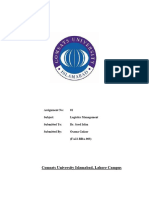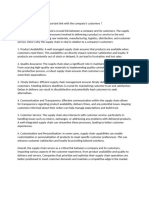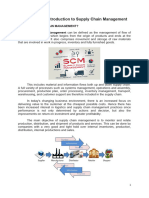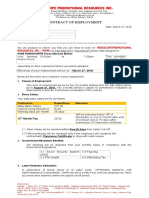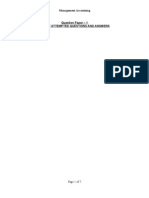0 ratings0% found this document useful (0 votes)
4 viewsSupply Chain Management
Supply Chain Management
Uploaded by
ahanaf3681Daraz supply chain management is the process of planning, controlling, and executing the flow and transformation of goods and services from raw materials to finished products to the end customer. It involves sourcing, purchasing, manufacturing, storing and distributing goods. The key stages are planning, obtaining goods, producing, delivering, and returning.
Copyright:
© All Rights Reserved
Available Formats
Download as DOCX, PDF, TXT or read online from Scribd
Supply Chain Management
Supply Chain Management
Uploaded by
ahanaf36810 ratings0% found this document useful (0 votes)
4 views7 pagesDaraz supply chain management is the process of planning, controlling, and executing the flow and transformation of goods and services from raw materials to finished products to the end customer. It involves sourcing, purchasing, manufacturing, storing and distributing goods. The key stages are planning, obtaining goods, producing, delivering, and returning.
Original Description:
Supply chain
Copyright
© © All Rights Reserved
Available Formats
DOCX, PDF, TXT or read online from Scribd
Share this document
Did you find this document useful?
Is this content inappropriate?
Daraz supply chain management is the process of planning, controlling, and executing the flow and transformation of goods and services from raw materials to finished products to the end customer. It involves sourcing, purchasing, manufacturing, storing and distributing goods. The key stages are planning, obtaining goods, producing, delivering, and returning.
Copyright:
© All Rights Reserved
Available Formats
Download as DOCX, PDF, TXT or read online from Scribd
Download as docx, pdf, or txt
0 ratings0% found this document useful (0 votes)
4 views7 pagesSupply Chain Management
Supply Chain Management
Uploaded by
ahanaf3681Daraz supply chain management is the process of planning, controlling, and executing the flow and transformation of goods and services from raw materials to finished products to the end customer. It involves sourcing, purchasing, manufacturing, storing and distributing goods. The key stages are planning, obtaining goods, producing, delivering, and returning.
Copyright:
© All Rights Reserved
Available Formats
Download as DOCX, PDF, TXT or read online from Scribd
Download as docx, pdf, or txt
You are on page 1of 7
supply chain management (SCM) is management of the
flow of goods, data, and finances related to a product or
service, from the procurement of raw materials to the
delivery of the product at its final destination.
Daraz Bangladesh, a subsidiary of the German e-
commerce giant Rocket Internet, was founded in 2012.
The platform started by offering a limited range of
products but quickly expanded to include a diverse array
of categories, from electronics and fashion to groceries
and the most selling item in daraz.
As of 2023, the best-selling categories on Daraz include:
Fashion: Clothing, shoes, and accessories are
perennial favorites.
Electronics: Gadgets, smartphones, and accessories
have a strong presence.
Beauty & Health: Cosmetics, skincare, and health
Supply chain management process
This is a picture of (SCM) Supply chain manage
Daraz supply chain management is the process of
planning ,controlling ,and executing the flow and
transformation of goods and services and from raw
materials to finished products to the end customer. It
involved in sourcing ,purchasing ,manufacturing , storing
and distributing goods.
. Planning
To begin developing a supply chain process, companies
need to plan out how they will operate. For example, if a
business is selling a children's toy, then the owners need
to strategize if they will purchase the toy's components
from a supplier, manufacture the component, or buy the
entire toy from a production facility.
In the case that the company decides to manufacture the
entire product, they must then identify which raw
material supplier they should work with. Additionally,
management teams need to decide how the goods will
be produced. For example, they can be produced and
stored in inventory, be made-to-order, or be partially
manufactured and finished when a customer places an
order.
The supply chain planning stage also requires designing
and organizing the company's warehouse, manufacturing
plant, and stores to ensure efficient travel time between
sites. Executives should also establish key performance
indicators (KPIs) and collect data about the market to
project and keep track of their productivity.
By comprehensively planning, companies can align their
supply chain to their business model, ensure
collaboration between all parties within the network, and
monitor the effectiveness of their strategies.
2. Obtaining Goods
Once businesses have planned out who their suppliers
will be, they must arrange contracts and set standards for
delivery schedules and payments. Companies should
ensure thorough communication with all suppliers, as
well as track and manage inventory to maintain proper
stock levels.
Performance of suppliers, such as lead times, should also
be frequently assessed to make sure the requirements of
delivery and products are met.
3. Producing
At this stage, businesses are testing goods,
manufacturing or assembling the final products, and
packaging them for consumers. To make sure that the
business is meeting production goals, data regarding
employee and sales performance should be monitored.
This will enable management to make necessary
adjustments to employee schedules or production levels.
Managers should also create compliance standards for
facilities to ensure that products and supplies are
properly treated, stored, and disposed of.
4. Delivering Products
Not only does the delivery stage involve distributing and
transporting finished goods to retailers and consumers,
but it also encompasses answering inquiries that
customers have about a product.
Businesses should also be conducting inventory
management to make sure products are organized in the
warehouse, stored appropriately, and monitored to
prevent obsolescence.
To streamline this process, management should
implement a digital inventory management solution.
These cloud-based tools enable authorized users to
accurately track inventory, as well as send orders and
automate invoices.
5. Processing Customer Returns
Processing and managing returns are often necessary
when dealing with defective products. At this stage,
employees must identify the condition of the item and its
flaws, authorize customer returns, process refunds, and
replace obsolete items with new ones. This will enable
positive customer service and can improve customer
relationship management.
Products that are at the end of their lifecycle, meaning
they no longer have market demand or value, are also
monitored at this stage because they contribute to the
inventory of unsalable and returned items. It is important
to assess product performance and conduct frequent
quality control to prevent extra costs to carry and remove
unwanted products from the warehouse.
Key Takeaways
An effective supply chain process ensures goods are
created and delivered to customers.
There are 3 elements to a supply chain- external
suppliers, internal processes, and external
distributors.
The 5 stages of a supply chain process are planning,
obtaining goods, producing, delivering, and
returning.
To streamline supply chain management and
monitor inventory, businesses should use inventory
administration software.
Must-Read Content
Elements of the Supply Chain Process1. Planning2.
Obtaining Goods3. Producing4. Delivering Products5.
Processing Customer Returns
You might also like
- Moglix Corporate ProfileDocument16 pagesMoglix Corporate Profilelucky sharmaNo ratings yet
- Financial Statement Analysis-Test BankDocument35 pagesFinancial Statement Analysis-Test BankSameh Yassien100% (1)
- Supply Chain ManagementDocument38 pagesSupply Chain Managementharish chandra67% (3)
- What Are The Four Elements of Supply Chain Management?: Element One: IntegrationDocument4 pagesWhat Are The Four Elements of Supply Chain Management?: Element One: IntegrationaryaNo ratings yet
- Internal Financial Control IFC Self Assessment ChecklistDocument5 pagesInternal Financial Control IFC Self Assessment ChecklistJasmine Iris Bautista100% (1)
- Tata Firmansyah - 018 - Assignment Job Order CostingDocument8 pagesTata Firmansyah - 018 - Assignment Job Order CostingTata FirmansyahNo ratings yet
- Chapter 3Document10 pagesChapter 3harleycrispino.eduNo ratings yet
- Supply Chain ManagementDocument4 pagesSupply Chain ManagementKritika ThakurNo ratings yet
- Supply Chain Management TrainingDocument8 pagesSupply Chain Management Trainingcicilia yobuNo ratings yet
- Supply Chain Management NotesDocument4 pagesSupply Chain Management NotesNadira RumaisaNo ratings yet
- Chapter 3Document32 pagesChapter 3Jelene SasaharaNo ratings yet
- Supply Chain and Logistics ManagementDocument76 pagesSupply Chain and Logistics ManagementVishal Ranjan100% (5)
- Supply Chain ManagementDocument6 pagesSupply Chain ManagementZehra Abbas rizviNo ratings yet
- Supply Chain and Logistics in MarketingDocument10 pagesSupply Chain and Logistics in MarketingvibuNo ratings yet
- Strategic Business Analysis-Reporting-Text-3Document6 pagesStrategic Business Analysis-Reporting-Text-3Christine Marie GazaNo ratings yet
- Cat One Principles of Supply Chain ManagementDocument17 pagesCat One Principles of Supply Chain ManagementRashid De RadianceNo ratings yet
- SCM - Unit-1Document20 pagesSCM - Unit-1Aashish Singh IINo ratings yet
- A Study On Supply Chain Management in Sakthinarayanan OverseasDocument31 pagesA Study On Supply Chain Management in Sakthinarayanan OverseasManju ManjuNo ratings yet
- Supply Chain Management - BBA404Document4 pagesSupply Chain Management - BBA404Anonymous K0ZhcHT2iuNo ratings yet
- SC MGT - Supply Chain Management in Hospitality Industry (PRELIM NOTES)Document13 pagesSC MGT - Supply Chain Management in Hospitality Industry (PRELIM NOTES)chloekent loreNo ratings yet
- Assignment On: Submitted To:Mohit Gupta Sir Submitted By: Akesh KumarDocument10 pagesAssignment On: Submitted To:Mohit Gupta Sir Submitted By: Akesh KumarAkesh GuptaNo ratings yet
- Unit-1 SCMDocument49 pagesUnit-1 SCMuinmbunkiNo ratings yet
- Supply Chain ManagementDocument19 pagesSupply Chain ManagementramNo ratings yet
- Unit 1 Supply Chain & Logistics Management KMBN OM01Document20 pagesUnit 1 Supply Chain & Logistics Management KMBN OM01richasoni98765No ratings yet
- Supply Chain Management (SCM)Document47 pagesSupply Chain Management (SCM)sean buenaventura100% (1)
- Report Supply Chain ManagementDocument39 pagesReport Supply Chain Managementamolktalekar50% (4)
- StrategicDocument54 pagesStrategicaltheamainacc642No ratings yet
- Ae Aesos Learning Packet No. 1 PrelimDocument31 pagesAe Aesos Learning Packet No. 1 Prelimsean buenaventuraNo ratings yet
- SCM NotesDocument166 pagesSCM Notesnandini_mba4870100% (1)
- Week - 3-Business Functions and Supply ChainDocument46 pagesWeek - 3-Business Functions and Supply ChainMr.CinnamonNo ratings yet
- Quản trị vận hànhDocument7 pagesQuản trị vận hànhNhi LêNo ratings yet
- Supply Chain Management TutorialDocument16 pagesSupply Chain Management Tutorialrahuldodiyat001No ratings yet
- Unit 1 - Supply Chain Managemnt MeaningDocument19 pagesUnit 1 - Supply Chain Managemnt MeaningSheela AngelNo ratings yet
- Supply Chain ManagementDocument59 pagesSupply Chain ManagementNyeko Francis100% (1)
- Retail ManagementDocument31 pagesRetail ManagementSushmita BarlaNo ratings yet
- Module 2.1Document7 pagesModule 2.1ParalogityNo ratings yet
- Rahul Final Project Final PDFDocument72 pagesRahul Final Project Final PDFNandan KesariNo ratings yet
- SCM Unit 1Document21 pagesSCM Unit 1Alok Arun MohapatraNo ratings yet
- Chapter 1Document22 pagesChapter 1Jelene SasaharaNo ratings yet
- SCM 301Document10 pagesSCM 301Manda simzNo ratings yet
- Acfrogaddhvtlsahyai7-Jrohywtxa Wy6cswalgcmcmap3azd Xqyaey7rvu81jhixqwwq9b95i G3dbfbrmifv7c4kqnkr3jlwkbtr2abugdpik82rpq6xmkyxho3574xseoywo6udeikakjhuDocument8 pagesAcfrogaddhvtlsahyai7-Jrohywtxa Wy6cswalgcmcmap3azd Xqyaey7rvu81jhixqwwq9b95i G3dbfbrmifv7c4kqnkr3jlwkbtr2abugdpik82rpq6xmkyxho3574xseoywo6udeikakjhuJoanna Mæ Nuñez SaysønNo ratings yet
- SUPPLY CHAIN MANAGEMENT AdjustmentsDocument39 pagesSUPPLY CHAIN MANAGEMENT Adjustmentsallanmsu2013No ratings yet
- Supply Chain ManagementDocument6 pagesSupply Chain ManagementRahul KumarNo ratings yet
- Placement Preparation - Supply Chain FundamentalsDocument20 pagesPlacement Preparation - Supply Chain FundamentalsTopsy KreateNo ratings yet
- 1-Introduction To Supply Chain ManagementDocument20 pages1-Introduction To Supply Chain ManagementMae JamolinNo ratings yet
- Paclar John MarkDocument6 pagesPaclar John MarkRina Peron DensingNo ratings yet
- Supply Chain Mgt. and Logistics AssignmentDocument18 pagesSupply Chain Mgt. and Logistics AssignmentDeeksha PantNo ratings yet
- Supply Chain Management Can Be Defined As The Management of Flow of Products and ServicesDocument42 pagesSupply Chain Management Can Be Defined As The Management of Flow of Products and ServicesRAJIT RANJAN CHOWDHARY100% (1)
- Research Project-: Study of Supply Chain in Hyper Store " (Big Bazaar)Document29 pagesResearch Project-: Study of Supply Chain in Hyper Store " (Big Bazaar)Vinay TiwariNo ratings yet
- SCM 0301 - CSDocument26 pagesSCM 0301 - CSGeorges LolcatsNo ratings yet
- Chapter 1 IntroductionDocument19 pagesChapter 1 IntroductionNazia EnayetNo ratings yet
- C1 IntroductionDocument5 pagesC1 IntroductionGovind UNo ratings yet
- Types of Control in The Supply Chain.Document7 pagesTypes of Control in The Supply Chain.Lesly SalinasNo ratings yet
- Unit 5Document7 pagesUnit 5Sheela AngelNo ratings yet
- Debritu AssignDocument5 pagesDebritu Assigngetamesay assefaNo ratings yet
- 3 - Supply Chain ManagementDocument15 pages3 - Supply Chain ManagementGurpreet BansalNo ratings yet
- Supply Chain and Wholesale ManagementDocument6 pagesSupply Chain and Wholesale Managementhyzelmae1No ratings yet
- Fa22 Rba 003Document7 pagesFa22 Rba 003Taskeen ZafarNo ratings yet
- 5Document3 pages5nganvo03012004No ratings yet
- 3 - Supply Chain ManagementDocument13 pages3 - Supply Chain ManagementGurpreet BNo ratings yet
- Supply Chain Management: Name-Diksha Patial CLASS-MBA (4sem) ROLL-NO-1710 Submitted To-Mr. Sachin SharmaDocument16 pagesSupply Chain Management: Name-Diksha Patial CLASS-MBA (4sem) ROLL-NO-1710 Submitted To-Mr. Sachin SharmaShivani KakkerNo ratings yet
- Chapter 1Document7 pagesChapter 1harleycrispino.eduNo ratings yet
- Materials Management Is Defined As "The Groupings of Management FunctionsDocument15 pagesMaterials Management Is Defined As "The Groupings of Management FunctionsAugusto Jr Rafael BasaNo ratings yet
- Manufacturing Secret : Product Development and Intelligent Manufacturing For Flexible Automation With Odoo 17: odoo consultations, #1.1From EverandManufacturing Secret : Product Development and Intelligent Manufacturing For Flexible Automation With Odoo 17: odoo consultations, #1.1No ratings yet
- Adissalem Asefa FinalDocument55 pagesAdissalem Asefa FinalSteven Kisamo AmbroseNo ratings yet
- Basic Framework of BudgetingDocument7 pagesBasic Framework of BudgetingJanellaNo ratings yet
- D PDF Sample Exam 2Document29 pagesD PDF Sample Exam 2seatow6No ratings yet
- Sap WM (Warehouse Management) Training - Sap WM Interview Questions and AnswersDocument2 pagesSap WM (Warehouse Management) Training - Sap WM Interview Questions and AnswersnikNo ratings yet
- Acc 31: Quiz 2Document1 pageAcc 31: Quiz 2Felimar CalaNo ratings yet
- InventoryDocument19 pagesInventoryrevanthNo ratings yet
- Ecological Site Inventory: Inventory and Monitoring Technical Reference 1734 - 7Document128 pagesEcological Site Inventory: Inventory and Monitoring Technical Reference 1734 - 7Abhishek JaniNo ratings yet
- Resume of GeraldSnellDocument2 pagesResume of GeraldSnellapi-24367927No ratings yet
- Study On Inventory Management in Bhandary Powerlines LTDDocument11 pagesStudy On Inventory Management in Bhandary Powerlines LTDRajendraNo ratings yet
- Advance Sap MMDocument74 pagesAdvance Sap MMRaghu NandanNo ratings yet
- Diaz Angelica PDFDocument5 pagesDiaz Angelica PDFSweetie HeartfiliaNo ratings yet
- Solution - Frequently Repeated Questions - CSCA 1Document4 pagesSolution - Frequently Repeated Questions - CSCA 1Shuborna FatemaNo ratings yet
- How To Read A Balance SheetDocument17 pagesHow To Read A Balance Sheetismun nadhifah100% (1)
- Store Keeper ConstructionDocument32 pagesStore Keeper ConstructionDinusha Nilan KumaraNo ratings yet
- EOQ StudyDocument4 pagesEOQ StudyJel-Anndrei LopezNo ratings yet
- Activity 11 19Document23 pagesActivity 11 19RyannDeLeonNo ratings yet
- 4.1 11 Steps To Create World Class OrganizationsDocument19 pages4.1 11 Steps To Create World Class Organizationsavnijain1987No ratings yet
- Property Facilities Manager in Austin TX Resume Jeff WigginsDocument2 pagesProperty Facilities Manager in Austin TX Resume Jeff WigginsJeffWiggins1No ratings yet
- Ellora Times Case StudyDocument9 pagesEllora Times Case Studyashpika100% (1)
- MM - Warehouse ManagementDocument29 pagesMM - Warehouse ManagementPurushotham kondaseni bhaskerNo ratings yet
- SCDL - Management AccountingDocument7 pagesSCDL - Management Accountingapi-373314867% (6)
- Problems 1 - Accounting Cycle PDFDocument17 pagesProblems 1 - Accounting Cycle PDFEliyah JhonsonNo ratings yet
- 01113-Lea NDocument26 pages01113-Lea NSasiKumar PetchiappanNo ratings yet
- Supply Chian ManagementDocument5 pagesSupply Chian Managementesteemed digitalNo ratings yet
- Logistics Management Unit-IDocument20 pagesLogistics Management Unit-IMageshwari G100% (1)
- AssetmcDocument33 pagesAssetmcAiden PatsNo ratings yet

























































